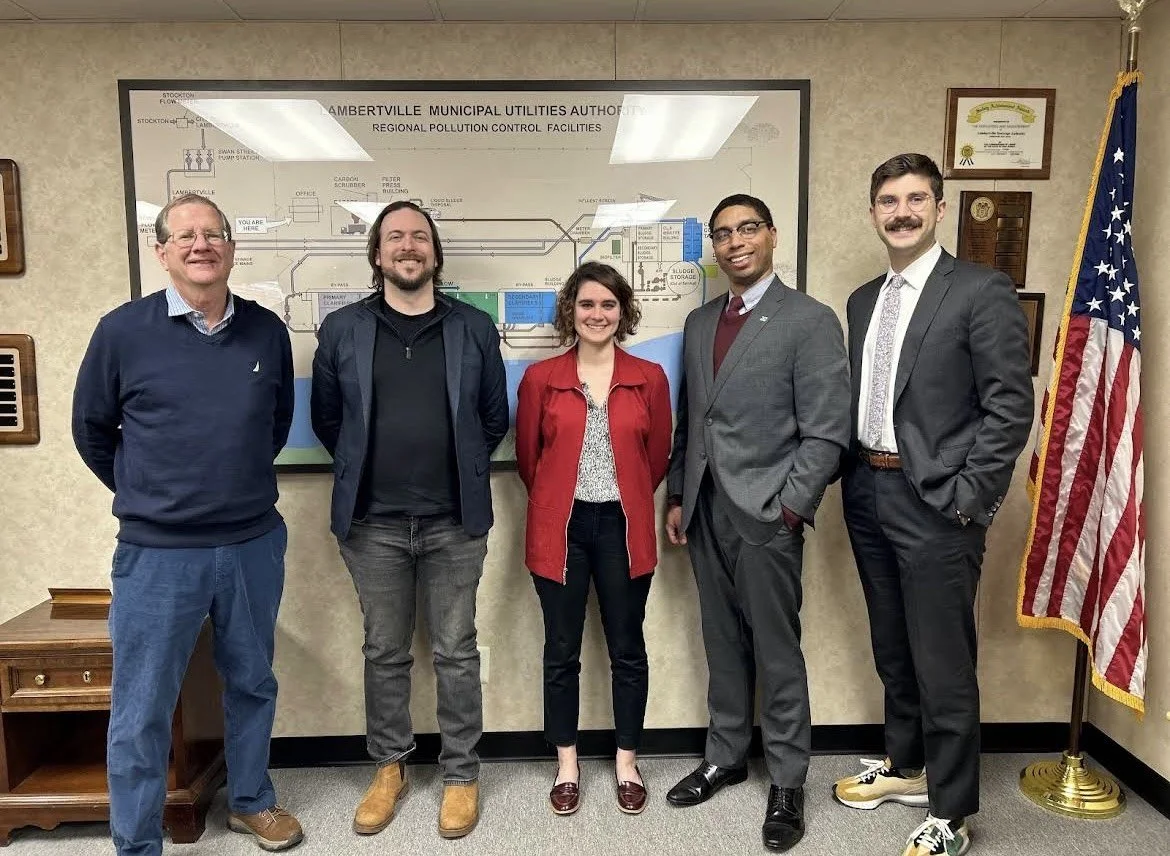Lambertville, NJ: Wastewater System Upgrades
January 2024 - September 2025
From Left to Right: Thomas Horn (ED of LMUA), Steve Barr and Christina Petagna (EPIC), and Lee Clark and Ben Dziobek (NJF) get together for a screening meeting.
Community Description
The Lambertville Municipal Utilities Authority (LMUA) treats wastewater for approximately 6,600 people across the City of Lambertville, NJ, Stockton, NJ, and portions of Bucks County, PA. The median household income is just above $100,000.
Project Scope
EPIC assisted LMUA with required application documents for the State Revolving Fund (SRF), the New Jersey Water Bank. Part of the application requirements for the Water Bank include an environmental planning document which identifies any environmental impacts, resiliency requirements, or needed permits.
Background and Services Provided
LMUA is a well run, mid-size wastewater utility. Prior to EPIC’s engagement, the utility had already completed feasibility studies for upgrades to two pumping stations and its wastewater treatment plant (WWTP). LMUA met with EPIC seeking assistance with the initial application steps for financing through the New Jersey Water Bank.
Executive Director Thomas Horn was connected to EPIC, via New Jersey Future (NJF), to explore options for funding the additional documents required for the applications, such as the environmental planning document (EPD). The EPD reviews project alternatives, potential environmental impacts, resiliency needs, and required permits. Even a well managed utility such as LMUA, one that regularly invests in their infrastructure and implements steady, incremental rate increases to fund the investments, is still challenged by the costs associated with an SRF application.
For the pumping station upgrades EPIC contracted with Remington and Vernick (RVE) for $21,007 to write up the EPD and review the necessary permits. For the WWTP, EPIC engaged Carroll Engineering, who performed the feasibility study, to draft the EPD for $18,900, and later contracted with the Colliers for $9,700 to prepare an amendment addressing updated permits and resiliency requirements that arose from design changes.
Challenges and Opportunities
| Type of Challenge | Project Experience | Outcomes and/or Opportunities |
|---|---|---|
| Governance/Financial | The cost of the required application documents can add up for small to mid-size utilities. Especially for something like an Environmental Planning Document which requires the sign off from a licensed engineer. | Many of the requirements that go into the EPD are available to be reviewed via the state’s GIS datasets and some of the required information is repetitive such as when an alternative is “no action”. For projects where the building footprint remains the same or for main line replacements where the disturbance is minimal, it makes sense for the state to make digital upgrades for the environmental review that would take the cost burden off of applicants and give time back to environmental reviewers. |
| Technical | Communication and timing challenges arose from lack of consistency in contracted services for many of the preliminary planning documents. | For the consistency of the project it is recommended that communities and utilities try to maintain the same engineering firm for the design and any additional required application documents, particularly when responding to review comments from the New Jersey Department of Environmental Protection (NJDEP). |
| State Level Governance | For the Water Bank portal some sections were confusing or process steps were not well explained resulting in incorrectly uploaded documents. | The state can provide more reference documents explaining what each section of the portal is for and what to expect with the submission of each application step. This can be provided in the form of reference documents or online videos walking applicants through the portal step-by-step. |
Project Next Steps
EPIC has concluded its engagement with LMUA and their design engineers will handle the remaining application steps. This includes but is not limited to the design, updated cost estimates, socially and economically disadvantaged (SED) contract utilization requirements, specifications for contracting, disbursement schedules, and bond resolutions approving long-term financing.


